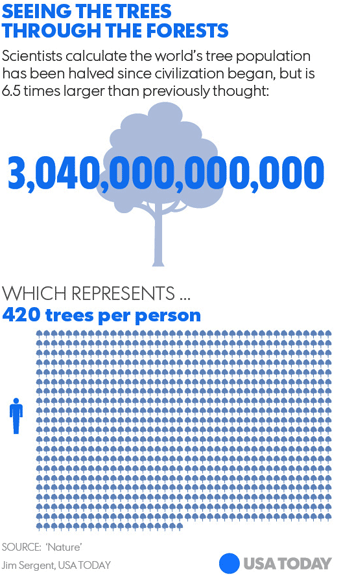 |
||||||||
| September 9, 2015 | ||||||||
| Rick's Tips - Water Jet Tail Cutting |  |
|||||||
|
· Subscribe to Ahead of the Curve · Newsletters · Ahead of the Curve archived issues · Contact the Editor
|
Wood you believe it? Earth has 3 trillion trees! (Editor's note: This article appeared in the September 2, 2015, issue of USA TODAY.) By Traci Watson, Special to USA TODAY  Three trillion. That's the staggering number of trees on Earth, according to a new tally that astounds even the scientists who compiled it. Three trillion is three followed by 12 zeroes, which is more than the number of stars in the Milky Way and more than the number of cells in a human brain. If the new sum is accurate—and other scientists think it is—the planet boasts roughly 420 trees for every living person. An earlier count pegged the global tree total at a mere 400 billion, but that study relied on less sophisticated methods. The gold medal for tree numbers goes to Russia, with 642 billion. The United States is fourth with 228 billion, behind only Russia, Canada and Brazil, although the United States lags behind many more countries in tree density. The figures are published in this week's Nature. There are more trees on Earth than stars in the Milky Way. The total is "astonishing," study co-author Thomas Crowther, who did the research as a postdoctoral student at Yale University, told reporters. When Crowther asked forestry experts to predict the total, they made wildly incorrect guesses, he said in a separate interview. "No one could comprehend the scale of the things we were seeing." In a more sobering find, Crowther and his team calculated that roughly 15.3 billion trees are cut down each year, and humanity has reduced the Earth's tree population by nearly half since civilization began. Around the world, one of the biggest influences on the number of trees is the corps of humans wielding chainsaws and axes. The scientists didn't have to count the world's trees one by one. But they still needed two years, data amassed by thousands of tree huggers and a good chunk of supercomputer time to add up all those oaks and palms and pines. The team combined actual tree counts made in wooded areas, around the world, with satellite pictures. By counting actual trees and comparing them to satellite pictures, they learned how to predict the number of trees in places where satellite views were the only source of information. The result is the first full-coverage map of the entire planet's tree density and one of the very few estimates that sees the trees and not just the forest. Other scientists cheered the new statistics. The three-trillion estimate is "reasonable" and based on good science, Richard Lucas, a professor of remote sensing and biogeography at Australia's University of New South Wales who was not involved with the study, said via email. The data will lead to a better understanding of global diversity, he said. The new information also speaks for the trees, which may seem endless but in fact are rapidly disappearing. The results provide "another way of saying we are really, really, really having an incredible impact on our natural ecosystems," said tropical forest ecologist Hans ter Steege of the Naturalis Biodiversity Center, a Dutch museum and research institute. The study shows "we've actually taken away almost half of the trees already. … That for me was pretty alarming." Now that you are Ahead of the Curve, stay there by joining TAPPI. |
|||||||
 |
||||||||